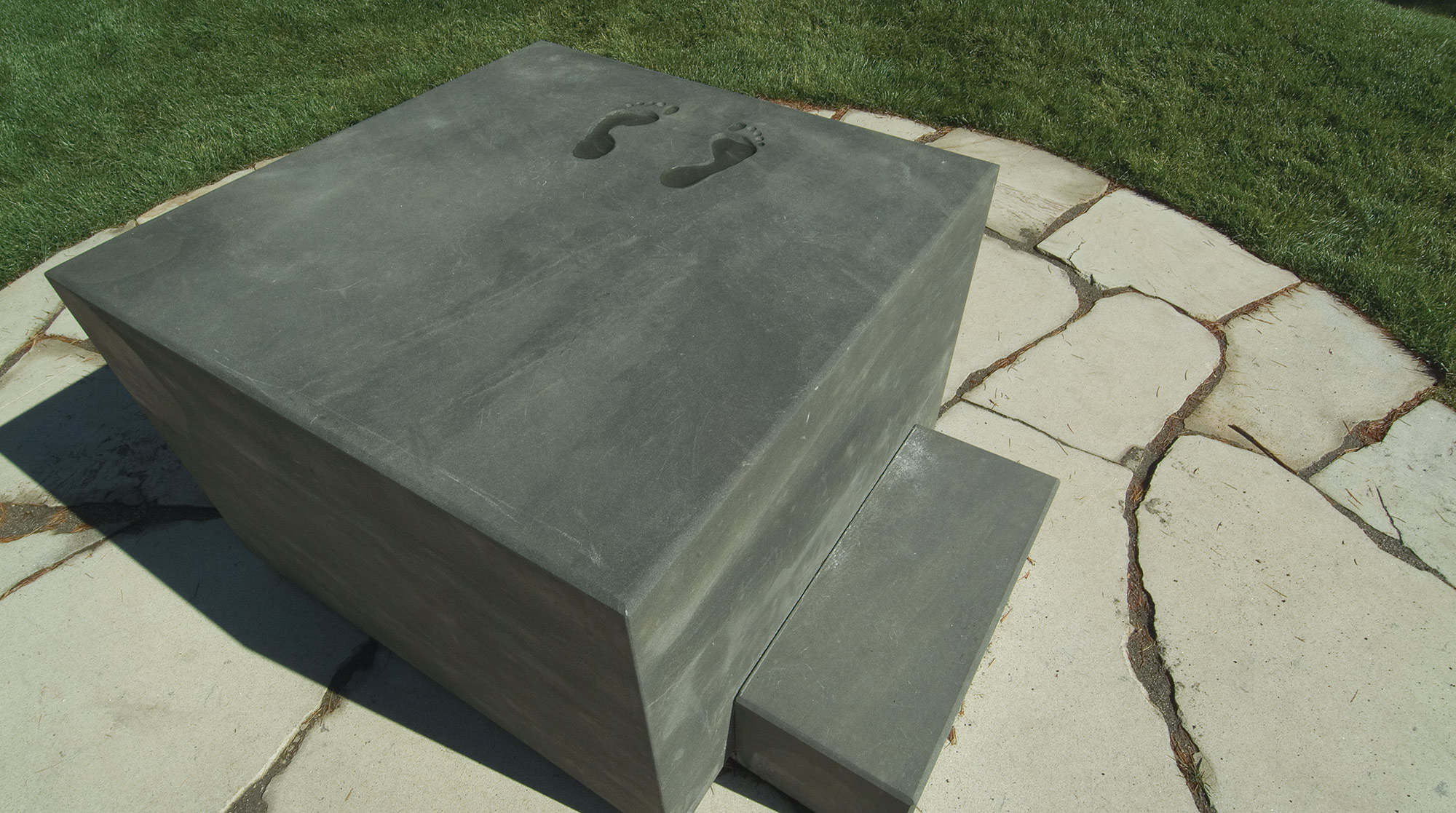

James J. Hill, the “Empire Builder,” glowers from atop his pedestal outside More Hall. Across the street, Jaebadiah Gardner, ’05, a 22-year-old of African and Mexican descent, glowers back at him.
“He looks like a plantation owner,” Gardner says.
In fact, Hill was a Minnesotan and a devoted Unionist, and his Great Northern Railroad helped put Seattle on the map in the late 19th century. But he was also an old-fashioned, tight-fisted tycoon. His Northern Securities Company was an early target of Teddy Roosevelt’s trust-busting efforts, and his labor practices were typical of his time –pay immigrants the lowest possible rate for the most punishing work.
The bronze bust looks to be about three times as large as an actual human head and shoulders, and the whole statue, pedestal included, is as tall as a person with a head that big would be. “He’s elevated,” Gardner says, strolling off down Stevens Way. “We’re being told to admire him.”
It’s not so much the presence of such statues on the UW campus that bothers Gardner. It’s their ubiquity, which, he feels, comes at the expense of more diverse artwork and contributes to a sense of invisibility among students of color.
“It’s a struggle, going to class every day,” he says. “Nobody looks like you. You’re talking about European history. You’re talking, basically, about everything that’s not you.” Gardner is a builder, too, but not of empires. On the median that divides the walkway between Mary Gates Hall and Suzzallo Library, there’s a new public monument to diversity. It’s also a monument to the dedication of Gardner and his good friend Sumona Das Gupta, who spent more than a year getting the administration’s attention, getting a special design-build class created, getting the money, getting the site and getting the thing made.
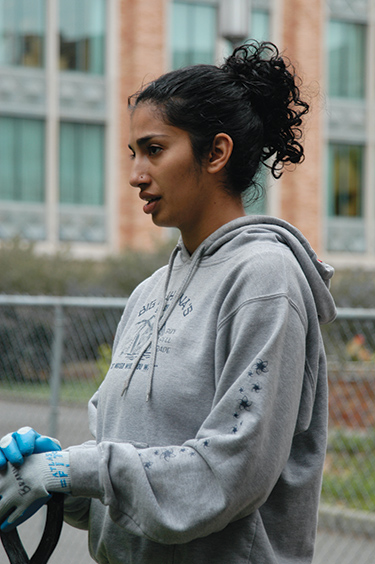
“I’m glad it was a team,” says Sumona Das Gupta, “because by myself, I would have given up after one year.”
Entitled “Blocked Out,” it, too, has a pedestal. But this one is unoccupied – a granite block with bare footprints carved on top. The stone circle at its base appears to be shattered, as though the block has fallen on it. From the circle’s perimeter, the grass ripples over a series of concentric wave-like berms. A few yards away, these waves meet a flagstone path and a semi-circular wall of rounded, multi-colored rocks. The wall, which resembles an ear when seen from above, has a bench-like shelf cut into its interior. Under a nearby cedar tree, a plaque reads “BLOCKED OUT” – dedicated to those who are excluded from the house they were exploited to create.”
It’s a complex collection of symbols, inviting participation and interpretation. But according to Erin Williams, ’05, a student in the class that produced it, the value of Blocked Out is more than merely symbolic. Williams wrote her senior thesis on recruitment and retention of African Americans at universities. “Basically, the numbers reflect the fact that if your campus has a better climate for people of color, they’re more likely to come and more likely to stay,” she says.
How can one piece of artwork help create such a climate? By being prominent and permanent, Williams says. “It means that the University is stepping up and saying, ‘Hey, we’re not going to put students of color on the back burner anymore.’ The more centrally, on a campus, that diversity efforts are made, the better the percentages of recruitment and retention. One of the largest African American student populations in the country is at Michigan, and their ethnic cultural center is right smack dab in the middle of campus. You can’t go across campus without passing it. That definitely makes it known that we’re here and we’re here to stay.”
Gardner recalls several of his friends from freshman year decamping for other schools after only a quarter or two. “I’m telling them, ‘Hang in there,’” he says, starting up the path between Drumheller Fountain and Red Square. “And they’re like, ‘No, man, you hang in there.’”
He stops in the middle of the square and gestures toward Suzzallo’s imposing facade, with its 18 terra-cotta figures standing saint-like in their niches: Plato, Gutenberg, Shakespeare, Benjamin Franklin. “All men,” Gardner says. “Virtually all European. All people who have been canonized within academia. The style is very Gothic, which is cool, but when it’s everywhere – and this is what everybody sees when they come to campus for the first time. Every tour stops in front of Suzzallo – ‘Here it is. What do you think?’ And I think, ‘I’m not in here. Or my family, or my friends.’”
***

The students conceived, designed and built Blocked Out — under budget — in 10 weeks time.
Gardner first began paying close attention to public art on campus in the fall of 2003, when the University announced that a statue of former football coach Jim Owens would be dedicated outside Husky Stadium. Owens, who came to the UW in 1957 and retired in 1974, was straight out of central casting – a hard-nosed Southerner who transformed a team with no winning tradition into a perennial Rose Bowl contender.
But his legacy has long been tarnished by allegations of racism: that he “stacked” black players at certain positions to limit their time on the field, that he punished them excessively, that he admonished them not to date white women. Owens, who is now in his late 70s, denies all of these charges, although he has expressed some regrets. The week of his statue’s unveiling, he met with former players in an attempt to reconcile, and told the media that he wished “we had done some things different” – gestures that satisfied some of his critics and struck others as half-hearted.
The statue was commissioned by Owens’ friends and former players (including one African American), and donated to the UW. What troubled Gardner and Das Gupta was the lack of discussion within the University community. One more bronze likeness of one more white man with an uneven record on race had simply materialized on campus. They and some friends decided to “flier” that year’s Apple Cup game—putting the case against Owens down on paper and passing it out to Husky fans. But Owens remains a popular figure. Not surprisingly, some of those fliers came flying right back in their faces.
Gardner and Das Gupta—well-known around campus as “J.B. and Sumona”—had a history of student activism. But this experience got them thinking for the first time about visual art as a vehicle for political messages. “The biggest thing we got from Jim Owens,” says Das Gupta, “was the idea that you can use art in powerful ways.” They agreed to refocus their efforts on a diversity monument, and began drawing up lists of deans and department heads, sending e-mails, making phone calls and knocking on doors.
Their initial inquiries met with plenty of encouragement, but after several months of meetings, Gardner and Das Gupta found that they were no closer to having a commitment from the University than they’d been at the start. “We completely got the runaround,” Das Gupta says. “Part of it was the fact that our idea was very innovative, so no one had a clue as to how to go about it. It wasn’t exactly like we were being discouraged – ‘We don’t want you to go through with it. ’ It was more like, ‘We want you to go through with it, but call me later. ’ Or, ‘Find somebody to help you, and if you need anything, come back.’ No one would really step up and say, here, let me get you through the door.’

Student Amanda Goodsell discusses a drawing of the monument in cross-section.
Finally, they found their way to Connie Kravas, vice president for development and alumni relations, who was impressed by their sincerity and determination. “They told me how many offices they had been to,” says Kravas. “So many places. And I’m thinking, ‘Oh my gosh. These kids are just giving their hearts and souls to this.’ But I never saw a twinge of anger or frustration from them.”
Kravas realized the students were in a bind – they would have trouble getting funding until they had a proposal, and trouble drawing up a proposal until they had some idea of where their money was going to come from. Taking their persistence as proof of their intent, she told them what they needed to be told: the buck starts here. She made a commitment to fund the inchoate project out of her department’s budget, and her staff subsequently rounded up contributions from nearly a dozen other UW units – including the president’s office, and intercollegiate athletics.
She also steered the students to a number of administrators who could help them bring the project into sharper relief. “All of us knew that this project would be a failure if it were forwarded as a reaction to the Jim Owens statue,” says Debra Friedman, a former director of special projects for development and alumni relations, who was recently named dean of the College of Public Programs at Arizona State University. “The project had to be freed from its roots. And the students understood that very quickly.”
“J.B. and Sumona talked about the campus not feeling comfortable and welcoming to students of color,” says Kurt Kiefer, the campus art administrator. “So one question we asked was, is this about image-making – about the fact that there aren’t images of significant people of color on campus? Or is it about place-making? Is it that there aren’t places that are comfortable?” The administrators, in turn, steered the students to John Young, a professor of sculpture and public art. For several years, Young has been teaching a design-build course that culminates in the creation of a piece of public art. Its past projects are all over the city, including “Give Voice,” a sunken space in the Campus Parkway median featuring steel megaphones, benches and an overturned table. Gardner asked Young to consider devoting the class to a diversity monument.
“And I said to him, ‘You need to do the following things, ’” Young recalls. “‘You need to come up with a budget, a minimum of $30,000, and you need to come up with a site on campus that they’re willing to allocate to this.” Every design-build has those two requirements. And so we had a very pleasant conversation, and I hung up, and I thought that would be the last I would hear from him.”
Young didn’t realize how many aces Gardner was already holding.
“Lo and behold, this kid comes up not with $30,000 but with $50,000 from UW development, and with two sites to consider on campus. When he did that, I had to take this course on.”
***
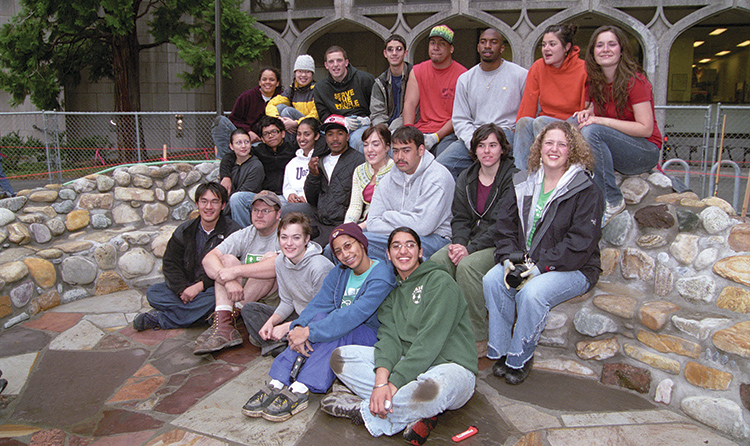
The class convenes one last time, sitting in the finished monument.
To give a sense of what the students were still up against, even after they’d secured their money, their site and their class, Friedman offers the following suggestion: “Take a blank piece of paper and draw a monument to diversity. Go ahead. Draw it.”
Compounding this challenge was the fact that the class, traditionally an upper-level studio course for artists deep into their majors, was half-full of students with no art experience at all. Young had made an exception to allow Gardner, Das Gupta, and other interested non-majors into the course. The learning curve for these students was steep, says Das Gupta, a senior majoring in biochemistry, “although I think we kind of brought a new flavor to the class, a new language.”
Given these obstacles, it’s all the more impressive that the class managed to produce such a sophisticated piece. Young split the students into five design teams and put together a professional advisory committee to review their proposals. From the five rough drafts that came back, the committee members identified two concepts they found particularly compelling. One was the block, which had begun as a doodle on Gardner’s sketch pad. The other was the ear. But it was the students who took these two elements and combined them so seamlessly.
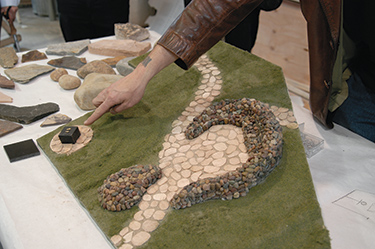
Originally the flagstone path was going to extend from one side of the grassy space to the other.
By itself, the block is already full of implications. It’s a base without a statue, for all those whose lives have gone uncommemorated. It’s an auction block from which slaves have been sold. It’s a platform from which people have been displayed – Gardner recalls seeing a photo of a Filipino man on a block at the 1909 Alaska-Yukon-Pacific Exposition. But the curving wall complicates it even further, turning the whole piece, potentially, into a sort of amphitheatre. At the dedication ceremony on June 11, just before graduation, no one needed to be told where to stand. The audience assembled in and around the ear, and the speakers assumed the pedestal.
“As you can see,” Young said from the block, “it’s been turned into a podium, a speaker’s box to celebrate free speech. It has been turned into something positive. The waves in the earth are shock waves that you’re standing on. Shock waves or sound waves, emanating from the story of this block, or from the voice of the speaker on the block.”
Yet the unity of the final composition is not necessarily a reflection of the class that produced it. There was real tension for much of the term, particularly between majors and non-majors. The activists worried that the finished piece would be abstract and toothless. The artists feared it would be so heavy-handed and bleak that students would alter their walking routes to avoid passing it.
“In the beginning of the class, you could see a complete segregation between art students and non-art students,” says Das Gupta. “During breaks, who hung out with who. Who was comfortable with who. Who was siding with who. It was a very segregated class, which is ironic, because that’s what we’re trying to combat, and the class can’t even figure that out.” Those barriers didn’t totally break down, she says, until the actual, physical site work began – six weeks of pouring concrete, slathering mortar and hoisting stones. Only then did the class really bond. “At that point, everyone’s on an equal playing field,” she says. “No one has more experience. It doesn’t matter who you are. Everyone can put a shovel in dirt and dig.”
***

On commencement day, students and their families gather at the campus’s newest landmark.
The tension is still palpable in footage of the April 27 class session, shot by a crew from UWTV that’s producing a documentary on the project for broadcast this month. A boom mike bounces between students as they argue over possible titles. Several are concerned that the word “Auction,” which has been forwarded, will limit the number of ways the block can be read. “Do you think ‘The Sale’ deals with auction, sufficiently?” asks Young.
“It makes me think of the Bon Marche,” says a student.
Eventually, the mounting frustration of a couple of students comes to the surface. “OK, all right,” says an Asian American student, Michio Imanaka. “You know, I was going to talk to you privately about this, John, but I can’t stand it anymore. I was turned on to this class because it’s a cultural diversity class, OK? … It’s not just a racism class. You’re working on a black and white issue. Where’s some gray in this? We’re the unrepresented. You guys keep thinking only about the black and white. There’s no gray.”
A classmate asks him to clarify. Gray?
“Asians!” Imanaka says.
“Railroads,” someone responds. “Garment workers. That’s also being sold. That’s labor being sold.”
“I don’t see myself in it,” Imanaka says. “Where are the Japanese Americans who were interned? I don’t see it.”
“I’m with you, bro. I’m here with you, man! I’m just saying that it’s completely the same thing. We’ve all been sold.”
Imanaka is unpersuaded. “I like the ‘sale’ idea,” he says. “I like the ‘sold’ idea. I don’t like the ‘auctioned off’ idea.”
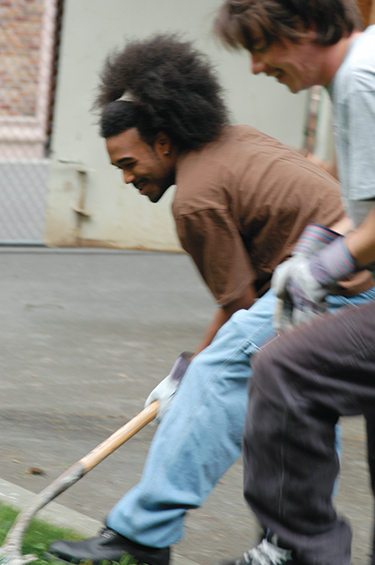
Jaebadiah Gardner, ’05: “This is what happens when students and faculty and administration collaborate.”
Young dismisses the class, asking them to continue the discussion over e-mail. Everyone slowly rises to leave. Mike Magrath, an affiliate instructor, seems bothered by the lingering uneasiness. “You guys,” he announces as the students disperse, “we’ve got a project. We’re just looking for a title. We win. We’re already there.”
Several weeks later, the students still hadn’t come up with a name that satisfied all of them. Fittingly, perhaps, the selection process that ultimately yielded “Blocked Out” included a coin toss. Friedman helped facilitate one of the final conversations on the subject, in which every student was asked to speak his or her mind. In that moment, she says, the full value of the class – including its tensions and resentments and hard-won friendships – came home to her.
“The thing that just astonished me,” she says, “was that those students really listened to each other. One would speak, and much later another would say, ‘I originally thought X. But now, after she spoke, I think Y. ’ And I thought to myself, ‘My God. I have been in ten thousand meetings as an administrator, and I don’t think I have ever heard someone so explicitly say, ‘I have learned from what you said. ’ These students really learned to listen to one another, even in the heat of the moment. We created for them a remarkable educational experience, and then they took it and made absolutely the most out of it that any of us could have imagined.”
That’s certainly true in the case of Erin Williams, who according to Young was always half an hour early for class. Williams says that the frictions between students had less to do with conflicting philosophies or clashing personalities than with the emotional investment everyone had in the project – in being part of something that had never happened before, and might not again.
“This project means so much to the people who made it,” she explains. “There’s so much pressure, not just from the University, but from yourself – you kind of feel like you’re representing your race, or underrepresented and unheard people everywhere. I think that’s why it got so intense for so many people. Because if not now, when? You always hope that there’s going to be another circumstance where you can make your voice heard. But if this is the only time, then, wow, we need to do this right.”